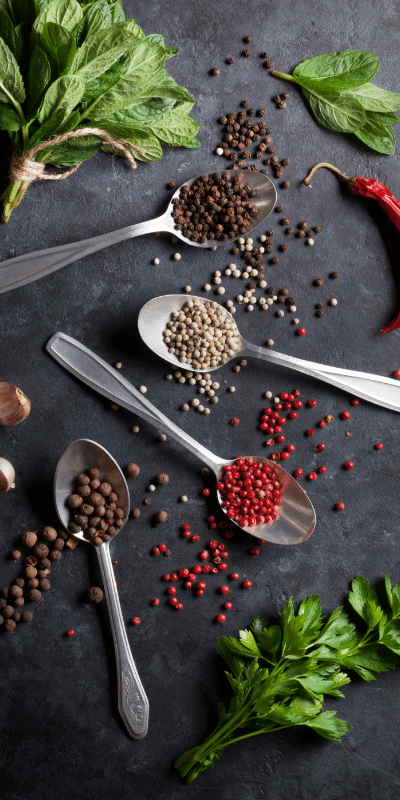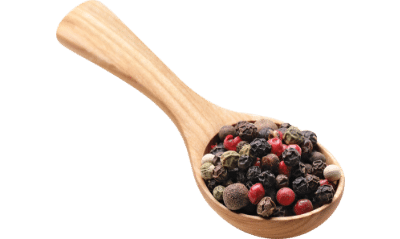
HEALTH
BENEFITS
There is no recommended limit on the consumption of pepper, as there is with salt.
The consumption of pepper is not linked to any undesirable health effects. It can be readily used in everyday cooking.
Literature provides evidence of the beneficial health effects of certain active ingredients in pepper. Piperine, for example, stimulates the production of saliva and gastric acid, and thus promotes healthy digestion. It can, however, irritate the gastrointestinal tract. Therefore, individuals suffering from stomach ulcers or gastritis should avoid pepper. Individual intolerances are always important to consider.
Nutritional
composition
When is the right
time to eat it?
Pepper can be eaten all year round.
Vegetable patch
or urban balcony?
Pepper is the fruit of the pepper plant, a species in the Piperaceae family. The plant grows as a vine, primarily in India, Vietnam, Brazil and Thailand, and includes various species.
You can grow your own pepper plant as long as you choose the right variety. In France, for example, black pepper plants can only grow in greenhouses.
The white flowers bloom in early summer; the fruit, or peppercorns, appear later in the season.
Peppercorns can be green, black or white depending on when they are harvested and how they are dried:
- Green peppercorns are harvested when not yet ripe.
- Sun drying green peppercorns result in black peppercorns.
- Red peppercorns are picked at full ripeness, and dried away from direct sunlight.
- White peppercorns are soaked in water, and their outer layer is removed.
The black pepper plant needs humus-rich soil that retains moisture but has good drainage. It needs hot temperatures but does not do well in direct sunlight. Sow seeds indoors in early spring.
Sichuan pepper is not actually pepper. It comes from an entirely different plant which, although not part of the pepper family, has similar characteristics and is used in the same way as traditional pepper. The Sichuan pepper plant can be grown in France, as it easily adapts to various climates. The plant is a spiky bush that grows up to four meters. Its pinkish-red peppercorns appear in October.
Sichuan pepper seeds can be sown outdoors in frost-free periods between spring and fall.
Choosing and
storing purslane
Fresh or pickled peppercorns should be refrigerated. Dried or freeze-dried pepper should be stored in an airtight container, in a cool, dry place. Since ground peppercorns rapidly lose their fragrance and taste, it is best to grind them just before use.
Tips and
tricks
Pepper loses its fragrance and taste once ground, so it makes sense that pepper lovers prefer it freshly ground. Grinding can be fine or coarse depending on the recipe and desired flavour. Coarsely ground pepper goes well on a steak; finely ground pepper is best for mashed potatoes or a soufflé.
Pepper can be used in all sorts of dishes, not only savoury ones. Some people add it to fruit salads for an extra kick!
What is the environmental impact of pepper ?
Pepper’s PEF score (Product Environmental Footprint) can tell us more! PEF scores are determined by Agribalyse*, which takes into consideration a vegetable’s life cycle: how it is grown, the environmental impact of transport and transformation, etc.
The lower the score, the lower the environmental impact.
- Ground white or black pepper: 1.32
- Raw beef steak: 2.77
*Data from the Agribalyse database, which compiles the environmental scores of food products. The unique score, a weighted average of 16 indicators, is calculated according to the European PEF methodology. It is not an environmental label or an eco-score.
CO2 equivalent: for 100 g of ground white or black pepper: 0.815 kg of CO2e, the same amount as for 24 g of raw beef steak.

Is pepper for everyone?
Due to its spicy hot taste, most kids shy away from peppery dishes. Furthermore, it is not recommended to give overly spicy food to young children so as avoid irritating their gastrointestinal tract. Case in point, individuals suffering from gastrointestinal diseases should avoid it.
A pinch of pepper is more than enough to suit everyone’s taste buds! Set it on the dinner table; everyone can add a bit more if they want to.
Where do they come from?
Origins and varieties
Pepper is a native plant to the Malabar Coast in southwestern India. In ancient times, peppercorns were considered rare and precious, and were used as currency.
Nowadays, pepper is grown mostly in Asia, specifically in India, Vietnam, Indonesia and Malaysia. Piper Nigrum is the only “real” pepper plant, and from it we obtain green, black and white peppercorns.



 Bitter greens
Bitter greens  Celeriac
Celeriac  Vegetable garden: growing lamb's lettuce
Vegetable garden: growing lamb's lettuce 









